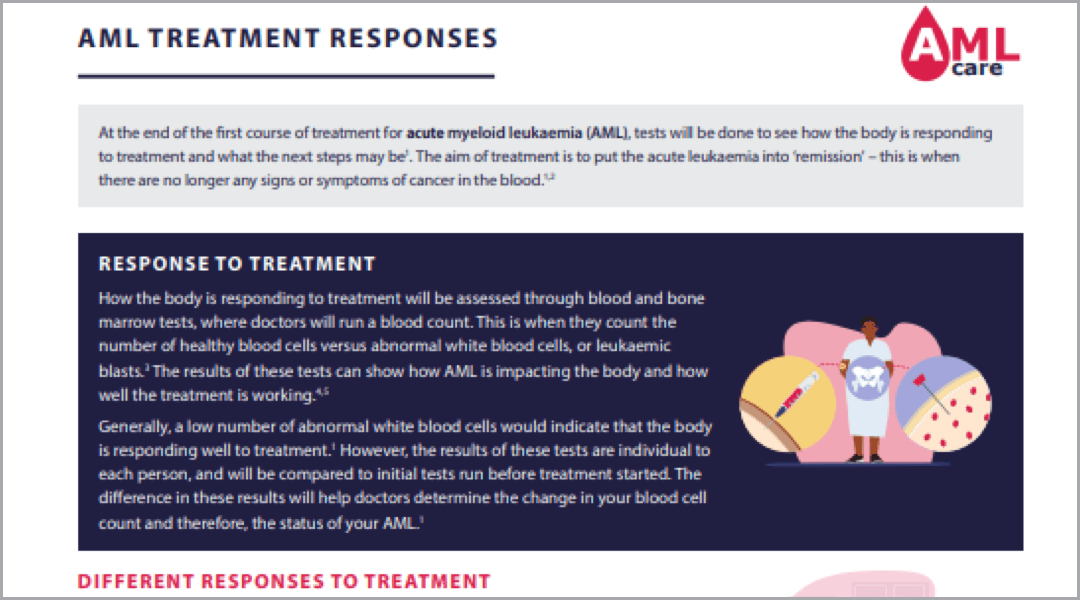Blood tests
Certain signs and symptoms may suggest that a person has acute blood cancer and if doctors suspect Acute Myeloid Leukaemia (AML), they will check samples from a person’s blood and bone marrow to confirm.1, 2
One of the first tests they will perform is a blood test. Typically, a blood sample is taken from the arm.
If AML is diagnosed, blood tests will be repeated throughout the management of the cancer.2
Does it hurt?
Everyone is different – some people may not notice that blood has been taken, while others may experience a short, sharp scratch on the skin, but it should only last a couple of minutes.3
Our Terminology Explained PDF guide is available to explain words or phrases you don’t fully understand.
What information does a blood test provide?


Blood samples let doctors count the number of healthy and abnormal cells being made, also known as a blood count.2 The results of these tests can show how AML is impacting the body and how well the treatment is working.2,4 Blood counts can also guide doctors and nurses on when additional treatments may be needed, such as a blood transfusion.2,4
Blood tests also provide information about how well the liver and kidneys are functioning.4 These parts of the body are vital in making sure AML treatments work, so it's good for doctors to keep an eye on them.

See how AML develops, based on the production of different cells
Seven handy tips before your next blood test
Handy tips before your next blood test
1. PHOBIAS
People with needle phobias may feel dizzy during or after the test. If this has happened to you before, just let your doctor know.
2. DISTRACTIONS
Try to distract yourself if possible. For example, by taking headphones and listening to some music while the test is being done.
3. CLOTHING
Wear short-sleeved clothing, so it's easy to take a sample from your arm, or wear a top with loose sleeves that can easily roll up above your elbow.
4. QUESTIONS
Remember, there is no such thing as a silly question. Your doctors and nurses may use new words that you’ve not heard of – if you don’t know what they mean, just ask. There is no expectation that you will remember everything, so don’t worry about asking the same question again.
5. PREPARATION
If you have questions, make sure you write them down. It can be easy to forget things when you’re speaking with your nurses and doctors.
6. SUPPORT
Remember, you can take a member of your family, a friend, carer or someone to support you to your clinic appointment. They can ask any questions you don’t want to or forget. Why not look at this checklist of questions to start with.
7. NURSES
But most importantly, remember that the nurses are there for you. If you are feeling anxious about your blood test, let them know. Although it might seem like a strange experience to you, they are experts in taking blood and will have done it thousands of times before. They will know plenty of ways to distract you and make the experience as pleasant as possible.
Support material

Understanding tests to diagnose AML
Download our handy one-pager, packed with information to help you or your loved one understand the tests used to check blood counts and monitor AML.

Questions to ask your doctor about the tests
Try taking this to your next appointment to guide the conversation and keep you in the loop.
Josh’s journey
Josh experienced a very quick diagnosis. Hear the advice he has for others who have just been diagnosed with AML.
Find out more about
Coming to terms with an AML diagnosis
Find out more information here
Bone marrow test
Find information on bone marrow tests, how to prepare and more.
References
1. MacMillan Cancer Support. Acute myeloid leukaemia (AML). https://www.macmillan.org.uk/cancer-information-and-support/leukaemia/acutemyeloid-leukaemia-aml [Last accessed: April 2022]
2. MacMillan Cancer Support. Acute Myeloid Leukaemia (Leukemia) Relapse. https://www.macmillan.org.uk/cancer-information-and-support/leukaemia/acutemyeloid-leukaemia-aml-relapse [Last accessed: April 2022].
3. Leukemia & Lymphoma Society®. Acute Myeloid Leukemia in Adults. https://www.lls.org/leukemia/acute-myeloid-leukemia [Last accessed April 2022]
4. Thol F, Gancer A. Treatment of Relapsed Acute Myeloid Leukemia. Current Treatment Options in Oncology. 2020; 21:66
HAE_2022_0033_IE | April 2022

